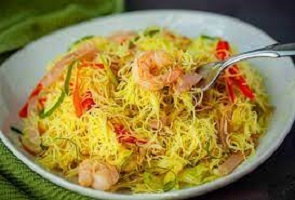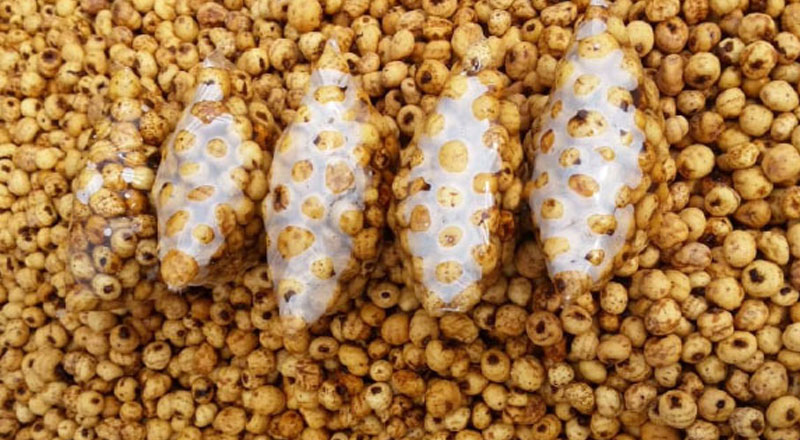Singapore Rice Noodles (Singapore Mei Fun) Recipe
Singapore Rice Noodles – It’s unclear where Singapore noodles stir-fried curried rice noodles with shrimp, pork, and vegetables come from, though it’s unlikely it’s Singapore.

Regardless, they’re a stir-fry staple that’s simple to prepare at home. From how to choose the perfect rice noodles to how to make the stir-fry work on a home burner, here’s everything you need to know.
Singapore Rice Noodles Recipe – How to Make Singapore Curry Noodles
In any restaurant, finding so-called “Singapore noodles” would be difficult, if not impossible. What would I do if I couldn’t find them? For starters, there are a slew of Chinese eateries to choose from
Related >>> Calories in Rice Noodles, Cooked Nutrition Facts
The thin rice noodles are stir-fried with shrimp, char siu (Chinese roast pork), and a variety of veggies after being seasoned with curry powder.
Its roots are a little hazy, but Singapore noodles are most likely as Cantonese as a bowl of wonton noodle soup: remove the curry spice and you have another Cantonese stir-fried rice-noodle dish called Ha Moon-style stir-fried rice noodles (Ha Moon Chow Mei Fun).
This explains why this meal is more likely to be found in a dai pai dong (open-air food stand) in Hong Kong than in a hawker center in Singapore.
The key to producing good Singapore noodles is to use the appropriate rice noodle.
There are probably rows and rows of different brands and sizes of rice-stick noodles if you have an Asian grocery nearby (sometimes also called rice vermicelli noodles).
It’s great to have a lot of options, but it can also be overwhelming. You’ll need a thin rice noodle that can withstand the heat of the pan and the movements of stir-frying without breaking apart.
A rice-stick noodle with the words “kong moon” on the label is ideal for this. Kong Moon, also known as Jiangmen, is a Chinese city in the Guangdong province. Kong moon-style rice noodles are made by a few different companies.
If you can’t find this type of rice-stick noodle, look for one that only has water and rice listed as components. Tapioca flour is used in some noodles, which I find too starchy for stir-frying.
Ingredients
- ¼ pound shrimp, shelled, deveined, and rinsed under cold water
- 2 tablespoons plus 4 teaspoons canola or vegetable oil, divided
- 1 teaspoon soy sauce
- 2 medium cloves garlic, minced
- 1 teaspoon Shaoxing wine
- 2 ½ teaspoons Asian fish sauce, divided
- ¼ teaspoon ground white pepper
- ¼ teaspoon sugar
- 2 eggs, beaten with two pinches kosher salt
- ¼ pound Chinese roast pork (char siu) or ham, cut into thin strips
- 1 bundle (about 5 ½ ounces) dried rice stick noodles
- ¼ medium onion, very thinly sliced
- ½ medium red bell pepper stemmed, seeded, and julienned
- 12 snow peas, stemmed, tough strings removed, and slice thinly on the bias
- ½ medium carrot, julienned
- 1 tablespoon curry powder, divided
- 2 scallions, sliced very thinly on the bias
- Kosher salt
- 2 teaspoons toasted sesame oil
Instructions
- To begin, dry the shrimp with paper towels and set them in a small bowl. 1 teaspoon canola oil and 1/2 teaspoon fish sauce are then added. Combine all of the ingredients in a large mixing bowl and set them aside in the refrigerator.
- Second, in a large mixing bowl, combine rice noodles and boiling water. Allow sitting for 5 minutes. Drain the noodles in a strainer, rinse with cold water, and drain until completely dry. Cut the bundle of noodles in half with scissors.
- In a small bowl, combine the garlic, soy sauce, Shaoxing wine, white pepper, sugar, and the remaining 2 tablespoons of fish sauce. Combine all ingredients in a mixing bowl and set aside.
- Fourth, in a wok or non-stick skillet, heat 1 teaspoon canola oil over high heat, tilting to swirl the oil, until smoking. After that, add the eggs and heat for approximately 10 seconds without stirring, then gently massage the eggs back and forth with a spatula until they begin to firm up. Break the eggs into small pieces in a large mixing dish and leave them aside.
- After that, clean the wok. Return the wok to high heat, add 2 teaspoons of oil, and continue to cook until the oil is smoking. Stir in the shrimp for 30 seconds. Stir-fry for another 30 seconds after adding the roast pork and onion. Stir in the red bell pepper and snow peas for another 30 seconds before adding the carrots. Season with salt and 1 teaspoon curry powder, tossing constantly until the curry is ready. Scrape the contents of the wok into the mixing bowl with the eggs.
- Wipe the wok clean once more. 2 tablespoons canola oil, heated over high heat until smoking Stir-fry the rice-stick noodles for 30 seconds. Combine the sauce and the remaining 2 tablespoons of curry powder in a mixing bowl. Stir until all of the curry powder has been dispersed evenly. Return the egg, shrimp, roast pork, and veggies to the wok and stir-fry for 30 seconds, or until everything is evenly incorporated. Last but not least, season with salt and remove from the heat. Add the scallions, sesame oil, and mix thoroughly before transferring to a large serving bowl. Enjoy right away.
Singapore Rice Noodles Recipe – Why It Works
- By cooking the stir-fry in stages, the wok can maintain a high temperature even on low-powered household burners.
- Using curry to season the shrimp, pork, and vegetables first, then the noodles, guarantees that all of the ingredients are ready.
Observations
On the label, look for rice noodles that say “kong moon” (Kong Moon, also romanized as Jiangmen, is a city in the Guangdong region of China).
You can also see Kong moon-style rice noodles from a few different companies. My personal favorite is the Double Swallow brand, although any brand with the “kong moon” logo would suffice.
This Singapore Rice NoodlesRecipe Appears In


